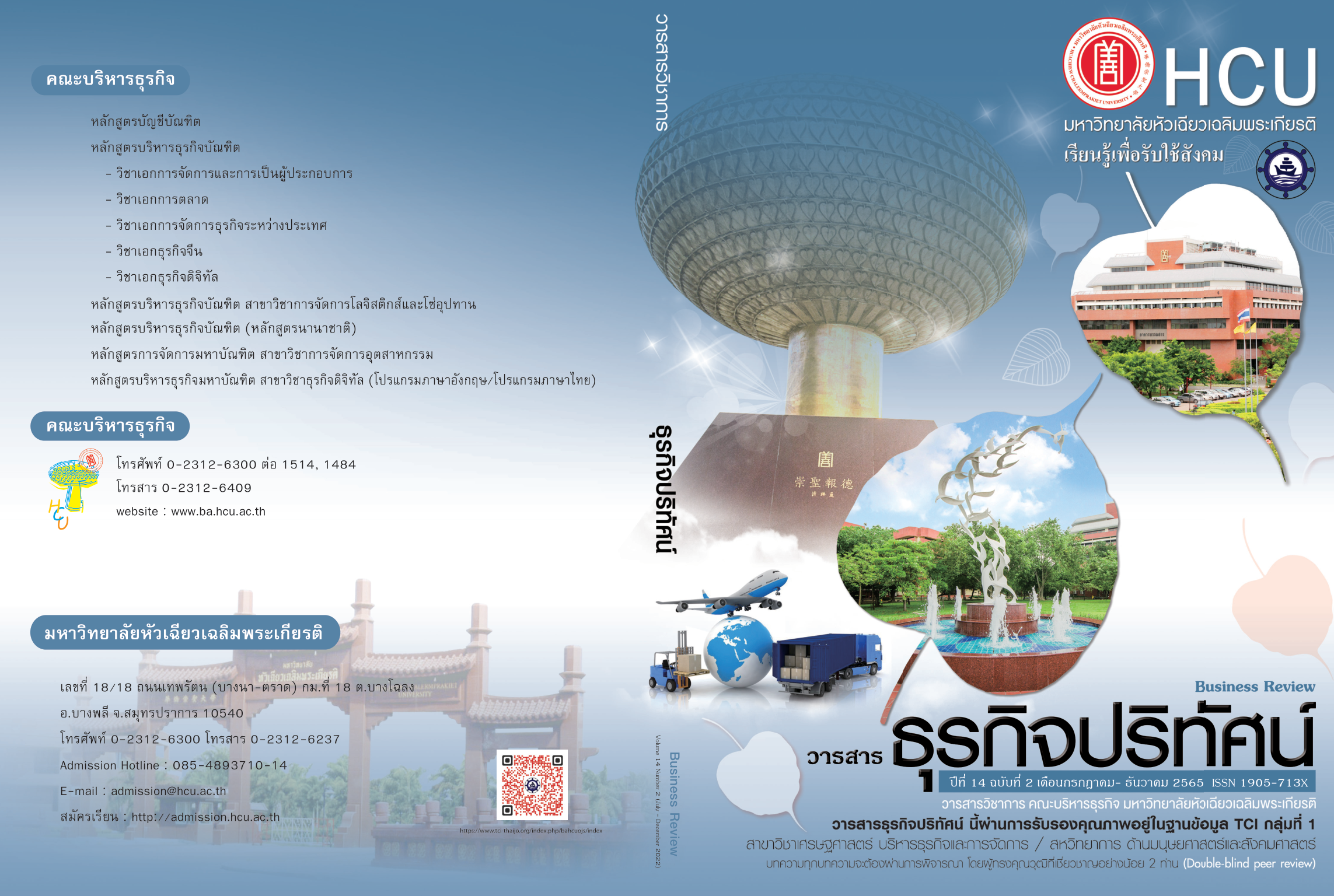Customer Journey of Fresh Fruits via Online Channel
Keywords:
Customer Journey, Customer Touchpoints, Fresh Fruit, OnlineAbstract
The purposes of this research were to investigate the customer journey and analyze customer touchpoints in purchasing fresh fruit via online channel. A customer journey began with pre-purchasing, during-purchasing and post-purchasing. Data were collected by in-depth interview from 24 fruit buyers and then analyzed by systematic coding analysis. The results demonstrated that in purchasing fresh fruit via online channel, the customer journey consisted of 7 stages 1) Awareness 2) Consideration 3) Preference 4) Purchasing 5) Feedback 6) Loyalty 7) Advocacy. Each stage has many touchpoints, but two key touch points were the post in Facebook seller (awareness stage) and the review of real buyers (consideration stages), which influence customer making decision. Thus, online sellers should focus on Facebook channel and clearly specifying the product details including reviews from customers. It would encourage repurchase and increase the sales and repurchase.
References
ณัฐนี คงห้วยรอบ และกนกพร ชัยประสิทธ์. (2560). การสื่อสารการตลาดแบบดิจิทัลที่มีผลต่อพฤติกรรมการซื้อสินค้าออนไลน์บนเว็บไซต์ LAZADA ในกรุงเทพมหานคร. วารสารวิชาการมหาวิทยาลัยอีสเทิร์นเอเชีย, 7(3), 349-355.
นิศารัตน์ อัครปัญญาวิทย์. (2564). การวิเคราะห์เปรียบเทียบเส้นทางผุ้บริโภคผลไม้สดระหว่างออฟไลน์และออนไลน์. วิทยานิพนธ์วิทยาศาสตรมหาบัณฑิต สาขาวิชาธุรกิจการเกษตร, มหาวิทยาลัยเกษตรศาสตร์.
นุชจรีย์ โชติพันธ์. (2563). การศึกษาเส้นทางผู้บริโภคมังคุดผลสด และความพร้อมของเกษตรกรผู้ปลูกมังคุดเข้าสู่ Digital Thailand 4.0. วิทยานิพนธ์วิทยาศาสตรมหาบัณฑิต สาขาวิชาธุรกิจการเกษตร, มหาวิทยาลัยเกษตรศาสตร์.
ปุณยวีร์ อิ่มแก้ว. (2562). พฤติกรรมการใช้เครือข่ายสังคมออนไลน์ในการซื้อสินค้าเกษตร กรณีศึกษา : ผลิตภัณฑ์เห็ดหลินจือแดง และผ้าพันคอพื้นบ้าน. วิทยานิพนธ์วิทยาศาสตรมหาบัณฑิต สาขาวิชาเศรษฐศาสตร์เกษตรและทรัพยากร, มหาวิทยาลัยเกษตรศาสตร์.
พิงคุณ สุขลิ้ม. (2562). การศึกษาเปรียบเทียบการรับรู้ความเสี่ยงที่ส่งผลต่อพฤติกรรมการซื้อสินค้าออนไลน์ระหว่าง Social Commerce และ E-Marketplace. วิทยานิพนธ์บริหารธุรกิจมหาบัณฑิต สาขาวิชาการจัดการเทคโนโลยีสารสนเทศทางธุรกิจ, มหาวิทยาลัยสงขลานครินทร์.
สลิลาทิพย์ ทิพยไกรศร. (2561). เส้นทางของผู้บริโภคในยุคดิจิทัล โจทย์ใหม่ทางการตลาด. วารสารปัญญาภิวัฒน์, 10(2), 294-302.
Følstad, A., & Kvale, K. (2018). Customer journeys: a systematic literature review. Journal of Service Theory and Practice, 28(2) 196-227. Doi.org/10.1108/JSTP-11-2014-0261
Gao, X., Shi, X., Guo, H., & Liu, Y. (2020). To buy or not buy food online: The impact of the COVID-19 epidemic on the adoption of e-commerce in China. PLoS One, 15(8), e0237900.
Yin, J., Chen, Y., & Ji, Y. (2021). Effect of the event strength of the coronavirus disease (COVID‐19) on potential online organic agricultural product consumption and rural health tourism opportunities. Managerial and Decision Economics, 42(5), 1156-1171.
Kotler, P. (1999). Kotler on marketing: how to create, win, and dominate markets. New York: The Free Press.
Kotler, P., Kartajaya, H., & Setiawan, I. (2016). Marketing 4.0: Moving from Traditional to Digital. New Jersey: Wiley.
Lemon, K. N., & Verhoef, P. C. (2016). Understanding customer experience throughout the customer journey. Journal of Marketing, 80(6), 69-96.
Litton, M. M., & Beavers, A. W. (2021). The relationship between food security status and fruit and vegetable intake during the COVID-19 pandemic. Nutrients, 13, 712.
Ludin, H., & Cheng, B. L. (2014). Factor influencing customer satisfaction and e-loyalty: Online shopping environment among the young adults. Management Dynamics in the knowledge Economy, 2(3), 462-471.
Meyer, C., & Schwager, A. (2007). Understanding customer experience. Harvard Business Review, 85(2), 116.
Meng-Hsiang, H., Chun-Ming, C., Kuo-Kuang, C., & Yi-Jung, L. (2014). Determinants of repurchase intention in online group-buying: The perspectives of DeLone and McLean IS success model and trust. Computers in Human Behavior, 36, 234-245.
Patterson, L. (2010). Using touch point effectiveness analysis to improve the customer experience. Visionedge Marketing. Retrieved Sebtember 1, 2021, from Visionedge Marketing Website: https://visionedgemarketing.com/wp-content/uploads/2006/12/using%20touch%20point%20effectiveness%20analysis%20to%20improve%20the%20customer%20experience.pdf
Rajini, G., & Krithika, M. (2016). Factor influencing online shopping intention: Impact of perceived risk. Advances in Natural and Applied Sciences, 10(10), 116-119.
Richards, T. J., & Rickard, B. (2020). COVID‐19 impact on fruit and vegetable markets. Canadian Journal of Agricultural Economics/Revue Canadienne d'agroeconomie, 68(2), 189-194.
Sturiale, L., Timpanaro, G., & La VIA, G. (2017). The online sales models of fresh fruit and vegetables: Opportunities and limits for typical Italian products. Quality-Access to Success, 18(S2), 444-451.
Suhartanto, D., Dean, D., Leo, G., & Nyoman, T. N. (2019). Millennial experience with online food home delivery: A lesson from Indonesia. Interdisciplinary Journal of Information, Knowledge, and Management, 14, 277-294.
Wei, Y., Wang, C., Zhu, S., Xue, H., & Chen, F. (2018). Online purchase intention of fruits: Antecedents in an integrated model based on technology acceptance model and perceived risk theory. Front Psychol, 9, 1521.
Xiaolin, L., Xuequn, W., & Hajli, N. (2019). Building e-commerce satisfaction and boosting sales: The role of social commerce trust and its antecedents. International Journal of Electronic Commerce, 23(3), 328-363.
Downloads
Published
How to Cite
Issue
Section
License
Copyright (c) 2022 Business Review Journal

This work is licensed under a Creative Commons Attribution-NonCommercial-NoDerivatives 4.0 International License.
All articles published in the Business Administration and Management Journal Review are copyrighted by the journal.
The views and opinions expressed in each article are solely those of the individual authors and do not represent those of Huachiew Chalermprakiet University or any other faculty members. Each author is fully responsible for the content of their own article. Any errors or issues found are the sole responsibility of the respective author.




